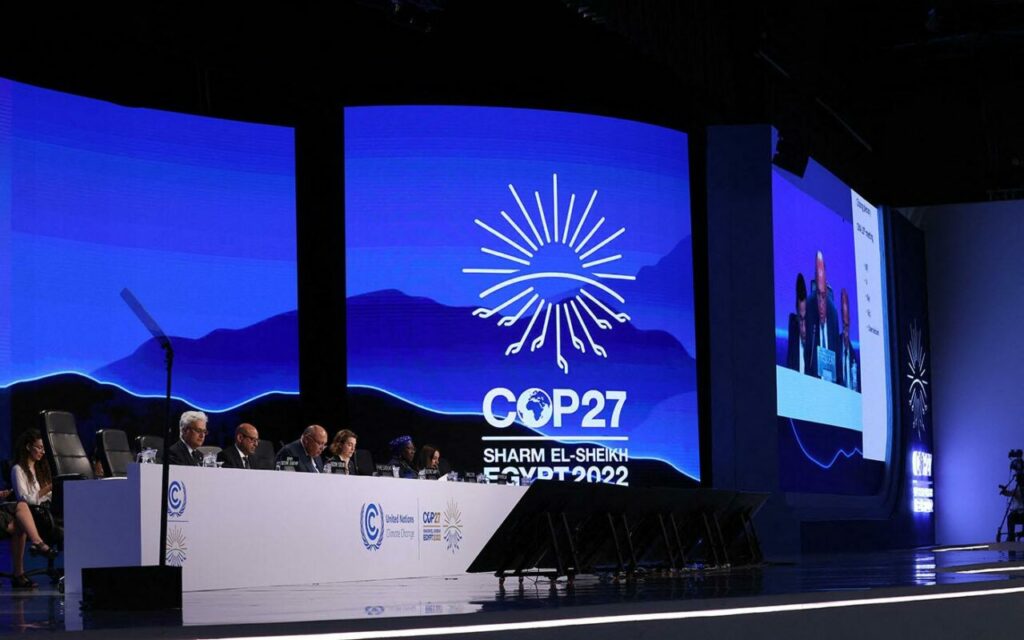The Sharm el-Sheikh climate conference produced what we anticipated in our pre-event newsletter: a combination of frustration with the climate emergency, and a sense of an event that has become obsolete in its current format. The conclusions confirm three lessons for companies and investors: the need to accelerate the necessary transformations for climate adaptation by relying on the few companies that are committed to getting their ecosystems on board; the need for clarity in positioning with political decision-makers and civil society; and the anticipation of growing turbulence, starting with learning to deal with an increasingly stronger and legitimized civil disobedience.
99% of companies still do not feel concerned by the Paris Agreement
COP 27 reaffirms a COP 21 achievement: Accelerate transformations to maintain a trajectory below 1.5°C
The main decision, known as the “chapeau” decision, is called the “Sharm el-Sheikh implementation plan”. It reaffirms the objectives set by the Paris Agreement. Namely, to contain global warming significantly below 2 ° C and continue efforts to limit the temperature increase to 1.5 ° C above pre-industrial levels, “recognizing that this would significantly reduce the risks and impacts associated with climate change” on the basis of the knowledge provided in this area by the IPCC in 2018.
Reaffirming what has already been concluded 7 years ago seems more like standing still than making progress. Or to remind the 99% of companies with more than 250 employees across the world that are not committed to any climate efforts that it is time to get started. Indeed, the Science Based Target Initiative estimates that it works with about 4,000 companies. But there are about 350,000 companies in the world with more than 250 employees. Therefore, stating the following is simplistic yet directionally right: 99% of companies are not currently committed to a climate trajectory, and many more are certainly not concretely engaged in the necessary calibration that allows economic activities to decarbonize to the extent necessary in order to reduce global net greenhouse gas emissions by 43% between 2019 and 2030. One can argue there is no need for an SME to activate the SBTI platform and define its very own trajectory. Being optimistic to believe this company would be working on its own on a trajectory halving its emissions in the few coming years would be as much simplistic and overly optimistic.
Lesson 1: It is essential to accelerate the transformations necessary for climate adaptation by relying on the few companies committed to getting their ecosystems on board
For the few companies and investors, generally among our clients and partners at Ksapa, who have made commitments as per the science of the 1.5°C trajectory, this invites a first lesson to be drawn: it is no longer enough to make a commitment but to explore one’s capacity to influence the commitment of one’s ecosystem to adopt ambitious, rapid and scientifically calibrated climate trajectories. To this end, companies and investors should:
1. Implement the trajectory and share efforts to show that the “4000” are taking action and not just making commitments
2. Organize support schemes by sector or territory to support companies that can be influenced in a low-carbon trajectory: customers – via incentives and service offers, territorial partners – via offers to share decarbonisation projects or the use of territorial renewables, suppliers – via incentives and support schemes
3. Give notice and set targets for commercial exclusion? We are already discussing with some clients thresholds that would make commercial exclusion eligible for new commitments by 2025, for suppliers who are not committed to 1.5°C by then for example
100% of governments in-charge of climate negotiations are under pressure from the double-talk of too many economic actors
Too little progress in climate negotiations, because the economic actors are double-talkers
The raison d’être of the COPs is first and foremost to organize negotiations between States on the coordination of a shared climate effort. To this end, COP 27 also produced a text that “urges” the parties that have not yet communicated new or updated NDCs (national climate plans) to do so as soon as possible before COP 28 in 2023. In particular, it calls for parties to revisit and strengthen their 2030 targets in order to align with the temperature targets stated in the Paris Agreement. To raise the ambitions of the States, it is important to take into account certain subjects which each have a strong leverage effect to amplify the climate trajectory of the States.
- Agriculture was only briefly mentioned during the negotiations. It represents 1/3 of the greenhouse gases, but only 3% of the active and earmarked funding in the COPs is dedicated to this sector. The carbon sequestration potential is huge. The technical trajectories allowing the conversion of thousands of hectares of land exist and are tested and known.
- Biodiversity: A few weeks before the COP 15 on biodiversity, the COP 27 underlines the importance of “protecting, conserving and restoring nature and ecosystems to meet the temperature targets of the Paris Agreement, through forests and other terrestrial and marine ecosystems acting as sinks and reservoirs of greenhouse gases and protecting biodiversity, while ensuring social and environmental safeguards”. That’s vague.
- Energy. On energy, the text certainly “emphasizes” the “urgent need for immediate, serious, timely and sustained reductions in greenhouse gases by parties in all sectors, including through increased use of renewable energy, just energy transition, partnerships and other cooperative actions. But the text remains basically as explicit as what was agreed upon during COP 26: riveted on the issue of coal while neglecting the other main fossil fuel sources of greenhouse gases – gas, oil. It’s like saying that with a one-wheeled bike you can pedal 100 km: it doesn’t work. The plan thus sticks to a “copy and paste” of the Glasgow pact while several delegations called for going beyond it. In the middle of the COP, India had proposed to include in the final decision the progressive reduction of all fossil fuels. A more ambitious proposal and a move also for it to no longer put pressure only on the large emerging countries heavily dependent on coal, but also on developed countries, more dependent on oil and gas.
These issues have not reached a consensus within the business and investment communities because they all have in common 1. the need for major capital mobilization efforts, 2. trajectories that take several years to recreate a profitable business model, while 3. decision-makers in decision-making positions are judged on their short-term results. It is therefore easier to hold a double discourse, on the one hand, with a view of “embracing the cause of sustainable development”, while explaining behind the scenes to negotiators and States that nothing is possible if others do not do more first.
Lesson 2: Clarify climate transition plans and stop the double talk
The climate emergency is part of our daily lives. This double talk that prevents action is not only not credible, but also untenable. Governments are called upon to act under increasing pressure from society as well as from new regulatory requirements. Thus, it is urgent for companies to :
1. Project a business model adapted to the climate situation and organize the transition
2. Organize financing schemes, possibly in discussion with shareholders and financial partners. 2022 has seen record dividends in many sectors. Some sectors are operating with margins of over 25%. Many sources of financing that can be partially allocated to a transition fund while reassuring financial partners and shareholders who can keep comfortable returns…
3. Align the internal discourse in organizations to ensure that the messages are consistent with the functions and interlocutors
State bodies discredited
A climate crisis that in 30 years does not find the “magic” financing that the pandemic crisis found in less than 3 years
The International Monetary Fund easily calculates that at least USD 9 TRILLION has been spent in emergency by the States in the world to manage the Covid crisis. For 10 years, developed countries have not been able to find USD 100 billion per year to help developing countries. In this context, the establishment of a loss and damage mechanism and the Santiago network, whose text provides for the establishment of financial arrangements to assist the most vulnerable developing countries, is a challenge and a major test to restore or totally discredit the commitment of the developed countries. Expected for 30 years by the small island states in particular, and then supported by the G77 and China, it could amount to a few hundred million euros, now supported by the European Union and the United States… provided that China contributes.
With this type of debate, States lose their credibility. It is true that geopolitical stakes influence their positions. Certainly, there is no “magic” money. It is true that COPs follow one another with more and more coalitions that say they are committing billions and trillions to support the climate cause. But the IPCC curves do not change. The IPCC predictions are part of everyday life. The money promised is not being disbursed to the extent of the stakes.
Lesson 3. Anticipation of growing instability, starting with learning to deal with an increasingly strong and legitimized civil disobedience
With one year to go before the first global assessment, set in the Paris Agreement for 2023, i.e. two years before the publication of new NDCs, we can bet that there is a great deal of frustration and that it will increasingly fuel lawsuits and other climate disobedience actions.
Climate disobedience issues will multiply and seriously question many democratic and administrative processes managing land use planning issues for example. Companies will have to learn how to conduct constructive debates, in democratic and respectful spaces, while facing exponential resistance regarding the climate acceptability of their activities. Here again, the only answer will be their ability to propose a credible climate approach for themselves, while exerting the necessary influence on their economic ecosystem to do the same.
Conclusion
Now that scientific forecasts are part of everyday life, and that the explosion of energy costs justifies accelerating efforts in energy efficiency, decarbonization and the acceleration of renewable development plans, these COPs generate expectations that they are no longer able to satisfy. It is up to companies and investors to draw and act on the 3 lessons learned in this article. Ksapa brings 25 years of expertise and an international network to navigate these complex issues, while organizing the technical plans, investment schemes and stakeholder organization necessary to understand, decide and act at the necessary level and speed.
Author of several books and resources on business, sustainability and responsibility. Working with top decision makers pursuing transformational changes for their organizations, leaders and industries. Working with executives improving resilience and competitiveness of their company and products given their climate and human right business agendas. Connect with Farid Baddache on Twitter at @Fbaddache.





